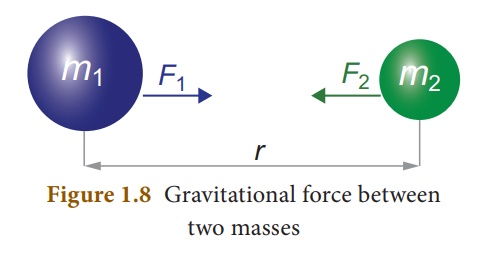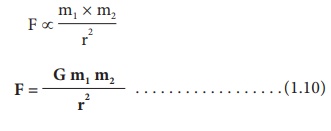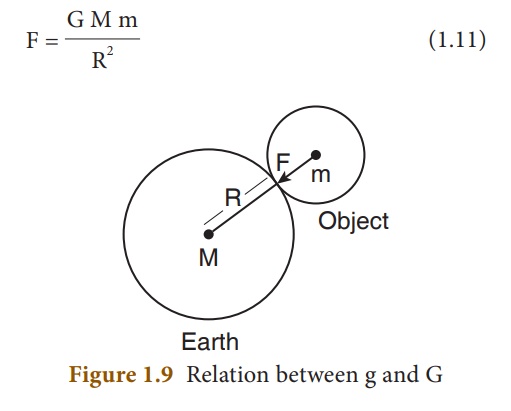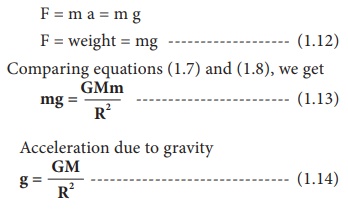Chapter: 10th Science : Chapter 1 : Laws of Motion
Gravitation
GRAVITATION
1. NewtonŌĆÖs universal law of gravitation
This law states that
every particle of matter in this universe attracts every other particle with a
force. This force is directly proportional to the product of their masses and
inversely proportional to the square of the distance between the centers of
these masses. The direction of the force acts along the line joining the
masses.
Force between the masses
is always attractive and it does not depend on the medium where they are
placed.

Let, m1 and m2
be the masses of two bodies A and B placed r metre apart in space
Force F ŌłØ m1 ├Ś m2
F ŌłØ 1/ r2
On combining the above
two expressions

Where G is the universal
gravitational constant. Its value in SI unit is 6.674 ├Ś 10ŌĆō11 m2
kgŌĆō2.
2. Acceleration due to gravity (g)
When you throw any
object upwards, its velocity ceases at a particular height and then it falls
down due to the gravitational force of the Earth.
The velocity of the
object keeps changing as it falls down. This change in velocity must be due to
the force acting on the object. The acceleration of the body is due to the
EarthŌĆÖs gravitational force. So, it is called as ŌĆśacceleration due to the
gravitational force of the EarthŌĆÖ or ŌĆśacceleration due to gravity of the
EarthŌĆÖ. It is represented as ŌĆśgŌĆÖ. Its unit is m sŌĆō2
Mean value of the
acceleration due to gravity is taken as 9.8 m sŌĆō2 on the
surface of the Earth. This means that the velocity of a body during the
downward free fall motion varies by 9.8 m sŌĆō1 for every 1
second. However, the value of ŌĆśgŌĆÖ is not the same at all points on the surface
of the earth.
3. Relation between g and G
When a body is at rests
on the surface of the Earth, it is acted upon by the gravitational force of the
Earth. Let us compute the magnitude of this force in two ways. Let, M be the
mass of the Earth and m be the mass of the body. The entire mass of the Earth
is assumed to be concentrated at its centre. The radius of the Earth is R
=ŌĆē6378 km (= 6400 km approximately). By NewtonŌĆÖs law of gravitation, the force
acting on the body is given by

Here, the radius of the
body considered is negligible when compared with the EarthŌĆÖs radius. Now, the
same force can be obtained from NewtonŌĆÖs second law of motion. According to
this law, the force acting on the body is given by the product of its mass and
acceleration (called as weight). Here, acceleration of the body is under the
action of gravity hence a = g

4. Mass of the Earth (M)
Rearranging the equation
(1.14), the mass of the Earth is obtained as follows:
Mass of the Earth M = g
R2/G
Substituting the known
values of g, R and G, you can calculate the mass of the Earth as
M = 5.972 ├Ś 1024
kg
5. Variation of acceleration due to gravity (g):
Since, g depends on the
geometric radius of the Earth, (g ŌłØ 1/R2), its value changes from one
place to another on the surface of the Earth. Since, the geometric radius of
the Earth is maximum in the equatorial region and minimum in the polar region,
the value of g is maximum in the polar region and minimum at the equatorial
region.
When you move to a
higher altitude from the surface of the Earth, the value of g reduces. In the
same way, when you move deep below the surface of the Earth, the value of g
reduces. (This topic will be discussed in detail in the higher classes). Value
of g is zero at the centre of the Earth.
Related Topics